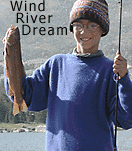
In 2001, we were redeemed in Wilderness. Louie Dawson 11 years old, Wilson Lake
As some of my older friends know, back in the 1970s I spent more than a year of my life in the Wind River mountains of Wyoming, working for the National Outdoor Leadership School (NOLS), and backpacking in for short-intense climbing trips to places such as Peak Lake and Dinwoody. I burned out on NOLS because you couldn’t make a living working for them back then, and other interests intruded on any Wind River plans. Thirty years passed by — but the Winds never passed from my spirit.
Last winter, after numerous knee surgeries, my wheels were functioning well enough to plan and train for a four day ski traverse in the Colorado Sawatch. While training via long walks and hikes, my mind wandered to the powerful wilderness experiences I’d had as a young man in the Winds. Could I do it again as a middle aged man, and share it with my family?
Returning to the Winds was mostly fantasy as I spent day after hot summer day pounding on my keyboard, trying to make a living as a writer and internet worker. Then one day I walked into our son Louie’s room as he was waking up in the morning. He sat up in bed and said, “Dad, I want to go backpacking — I mean for real, when we camp in a different place each night.”
Now where did that zinger come from, I thought to myself? Could it be that all 11-year-old boys have the wanderlust in their DNA?
In any case, the excuse to drop work was there. So after a summer of planning, we pulled off a 6-day backpack to Wilson Creek in the central Winds during August of 2001. The trip was everything I remembered, and more, since this time we had the added ingredient of a family. Overall, an incredible experience for Lisa, Louie, and myself.
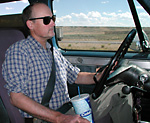
Driving our 1987 Suburban to the trailhead. One of the best vehicle we’ve ever owned as a backcountry recreation family.
The drive up from Carbondale was easy. All the roads have been improved immensely, with wide shoulders and smooth surface. You still have to watch for antelope and deer lounging on the pave, and don’t drive too slow, or you’ll endure the wrath of road-rage redneck death passers. We experienced several of those, but most of the trip was open road with minimal traffic. We were glad to be in our goliath Suburban, and even more psyched when we found cheap gas in Wyoming!
The trailhead at St. Lawrence Basin is typical Wind Rivers: A dozen or so cars parked, no people around, a few bugs. In a word, mellow. We parked, organized gear, checked the maps, and got a good night’s sleep.
As always, the first day with heavy packs was torture, but worth it. We spent our first night at a camp about halfway to the Wilson Lakes, then made the lakes the next day.
The stream next to our first camp was full of small brook trout, but they wouldn’t take a fly or spinner — at least not at the time we fished. Louie tried later, and yank, got one, his first Wind River fish!
We put away the tackle, got a good nights rest, and hiked to Wilson Lakes the next day. The moment we hit the first lake we stripped and dipped, then rigged the rods. First cast, 16 inch brown trout, a few more casts, another big fish. Louie was hauling them in like tuna. We kept a few, threw a few back. Fried the keepers on our MSR stove and had a big protein lunch right there five feet from the water.
The big fish we caught broke our leaders when we tried to land them without a net, so we made a net out of a limber pine branch and a mosquito head net. More fish to eat after that project was completed. I still have the DIY net as a keepsake.
While the Wilson Lakes are not the most pristine part of the Winds, the fish are big because they get fished enough to reduce the population, thus increasing food supply per fish.
While backpacking equipment has improved, it was interesting to note that the traditional cagoule rain garment was still the best thing we could find for summer wilderness travel. We like Gortex for short summer jaunts and winter expeditions, there is nothing like nylon with a thick coating of totally waterproof poly. We got our cagoules for about $30 each from a mail-order company that was popular in these days (Campmore), ordered out of a printed catalog by phone.
Most people don’t know that for the first few years of NOLS, back around 1968 (I graduated as a student in ’68), the school did not use gas backpack stoves but rather did all their cooking on fires, sometimes building up to 4 or 5 fires a day for various meals and such. With low-impact methods, it was amazing how evidence of those fires was not a problem.
When I was a NOLS student during a Wind Rivers course in 1968, we were actually instructed to leave our fires burning when we left camp, so that the coals would burn down to ash. Needless to say, once a Forest Service official ran across one of our unattended fires that practice was brought to a quick halt. We cooked on both our stove and fires during our 2001 trip, and used low-impact methods or existing fire rings so we didn’t mess things up.
We moved camp most days, spent evenings journal writing and cooking, and couldn’t believe the special ambiance of the rugged Wind Rivers. It was good to be back.
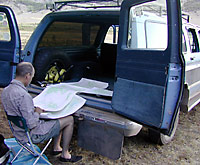
The former NOLSie got out the maps and put in the time. In 2001 backcountry GPS was just a concept for most of us, if that.
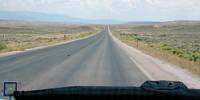
Almost to the trailhead, about 7 hours on the road from Colorado.
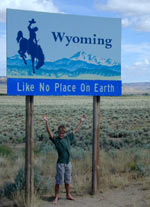
State border, indeed, like no place on earth!
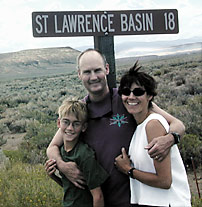
St. Lawrence Basin trailhead just up the road, super exciting to be here.
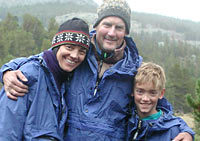
The weather was perfect, including an occasional afternoon shower to show us why we carried all our gear.
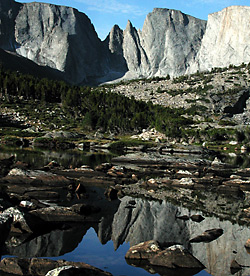
Thunderbolt and Lightning Rod Pinnacles rose south of the lakes. I admit to wanting my climbing gear, as well as the arms and legs I had 20 years ago. That wall on the right was especially enticing and over 2500 feet high!
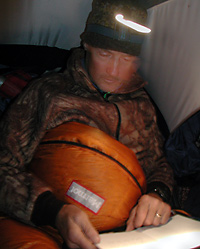
Every evening we read and wrote our journals — making memories.
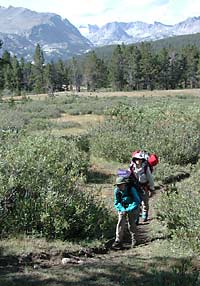
On the trail under Mount Lander.
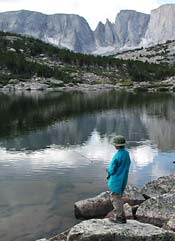
Can you imagine being eleven years old, and this is your first time fishing a Wind River lake, and you caught big cutthroat?
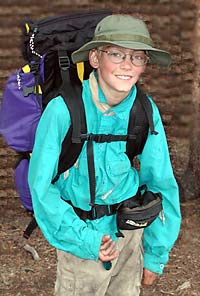
This was just so fun.
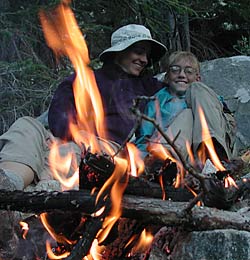
Campfires are sometimes frowned upon by today’s backpackers, but we don’t see any problem with them done thoughtfully in places with plentiful wood supply.
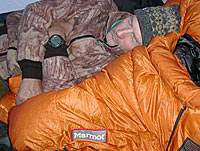
Me, napping. I was feeling the stress fall away like a mudslide peeling off a high rocky mountain. Though I did worry a bit about bears since we had a kid with us.
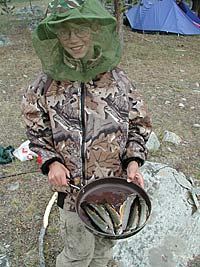
Louie cooking up his first catch.
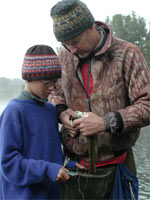
Passing on the wilderness skills.
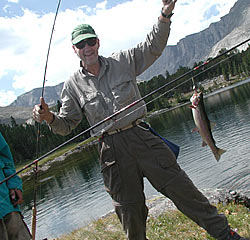
Dad rakes in another one.
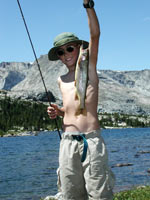
Oh yeah!
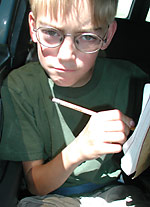
Louie didn’t get off totally free, a bit of journal writing was required each day. We stored the journals as keepsakes in our family archive.
WildSnow.com publisher emeritus and founder Lou (Louis Dawson) has a 50+ years career in climbing, backcountry skiing and ski mountaineering. He was the first person in history to ski down all 54 Colorado 14,000-foot peaks, has authored numerous books about about backcountry skiing, and has skied from the summit of Denali in Alaska, North America’s highest mountain.
